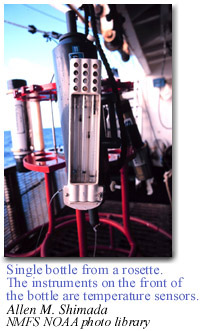![]() ow
do you catch a diatom?
ow
do you catch a diatom?
 Diatoms are typically collected by taking seawater samples in special
containers called Niskin bottles. These bottles are designed to
collect samples at specific depths in the water column and are often deployed
in a rosette. A rosette is a ring of multiple bottles. Individual
bottles in the rosette can be triggered to collect water at different
depths. Once water samples are collected and brought aboard ship, they
are filtered to isolate diatoms for viewing under a microscope.
Diatoms are typically collected by taking seawater samples in special
containers called Niskin bottles. These bottles are designed to
collect samples at specific depths in the water column and are often deployed
in a rosette. A rosette is a ring of multiple bottles. Individual
bottles in the rosette can be triggered to collect water at different
depths. Once water samples are collected and brought aboard ship, they
are filtered to isolate diatoms for viewing under a microscope.
 There
are two other ways of collecting diatoms. One way is to scoop diatoms
out of the water using net tows. However, the small mesh size required
to capture diatoms causes the net material to be easily clogged by larger
organisms. The other way is to sample sediments on the seafloor. Researchers
choose a particular method depending on whether they want to collect living
or fossil specimens.
There
are two other ways of collecting diatoms. One way is to scoop diatoms
out of the water using net tows. However, the small mesh size required
to capture diatoms causes the net material to be easily clogged by larger
organisms. The other way is to sample sediments on the seafloor. Researchers
choose a particular method depending on whether they want to collect living
or fossil specimens.
Since samples are full of materials other than diatoms, how does a researcher quickly separate the diatoms from other material? It is nearly impossible to pick out the very small diatoms by hand, even under a high-powered microscope, so the samples are prepared by destroying materials other than diatoms. By placing samples in acid and hydrogen peroxide solutions, carbonate and organic materials are conveniently destroyed, leaving siliceous materials such as opal. Voila! You have a nice clean sample. The silica-rich material is then carefully spread on a glass slide, where it is permanently mounted using a clear "glue". Once the researchers finish this procedure, the diatom samples can be examined and counted using a powerful microscope.
Figure. Slide of diatoms.
